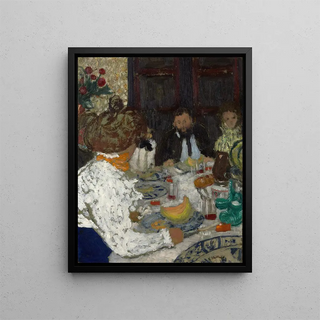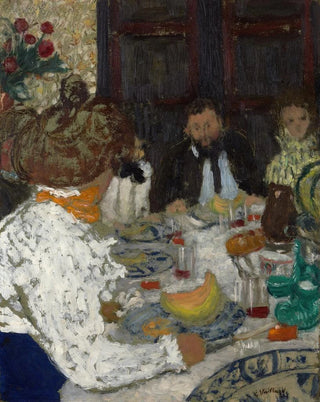Art print | Le déjeuner - Édouard Vuillard


View from behind

Frame (optional)
In the fascinating universe of art, some works transcend time and capture the very essence of the human experience. "The Lunch" by Édouard Vuillard is a perfect example, a painting that evokes the warmth of shared moments around a table, while revealing the complexity of human relationships. This masterpiece, painted at the end of the 19th century, is part of the Nabi movement, where subjectivity and intimacy take precedence over realism. Through this art print, the viewer is invited to immerse themselves in a world where light and color dance with rare delicacy, offering an immersion into the daily life of the depicted characters.
Style and uniqueness of the work
"The Lunch" stands out for its bold use of colors and patterns. Vuillard, master of atmosphere, manages to create an intimate ambiance, almost tangible, thanks to warm hues and subtly balanced touches of light. The figures, although stylized, are full of life and emotion. The artist plays with perspectives and planes, making the composition dynamic and engaging. The table, covered with delicate dishes, becomes the focal point, but it is the way the characters interact that truly draws the eye. Every gesture, every gaze is loaded with meaning, reflecting the intimacy of human relationships. The texture of the clothing, the pattern of the wallpaper—all contribute to creating a unique atmosphere, where the viewer feels both observer and participant.
The artist and his influence
Édouard Vuillard, an emblematic figure of the Nabi movement, knew how to combine modernity and tradition in his works. Influenced by the ideas of Paul Gauguin and the principles of symbolism, he developed a personal style that left an indelible mark on 20th-century art. His compositions, often centered on domestic life, reveal a sensitivity to the psychology of the characters and their environment. Vuillard was also a pioneer in using color to express emotions, a process that inspired many artists after him. His innovative approach helped redefine the aesthetic standards of his time.

Matte finish

View from behind

Frame (optional)
In the fascinating universe of art, some works transcend time and capture the very essence of the human experience. "The Lunch" by Édouard Vuillard is a perfect example, a painting that evokes the warmth of shared moments around a table, while revealing the complexity of human relationships. This masterpiece, painted at the end of the 19th century, is part of the Nabi movement, where subjectivity and intimacy take precedence over realism. Through this art print, the viewer is invited to immerse themselves in a world where light and color dance with rare delicacy, offering an immersion into the daily life of the depicted characters.
Style and uniqueness of the work
"The Lunch" stands out for its bold use of colors and patterns. Vuillard, master of atmosphere, manages to create an intimate ambiance, almost tangible, thanks to warm hues and subtly balanced touches of light. The figures, although stylized, are full of life and emotion. The artist plays with perspectives and planes, making the composition dynamic and engaging. The table, covered with delicate dishes, becomes the focal point, but it is the way the characters interact that truly draws the eye. Every gesture, every gaze is loaded with meaning, reflecting the intimacy of human relationships. The texture of the clothing, the pattern of the wallpaper—all contribute to creating a unique atmosphere, where the viewer feels both observer and participant.
The artist and his influence
Édouard Vuillard, an emblematic figure of the Nabi movement, knew how to combine modernity and tradition in his works. Influenced by the ideas of Paul Gauguin and the principles of symbolism, he developed a personal style that left an indelible mark on 20th-century art. His compositions, often centered on domestic life, reveal a sensitivity to the psychology of the characters and their environment. Vuillard was also a pioneer in using color to express emotions, a process that inspired many artists after him. His innovative approach helped redefine the aesthetic standards of his time.






